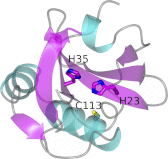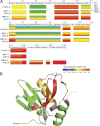Structure/function relationships of adipose phospholipase A2 containing a cys-his-his catalytic triad
- PMID: 22923616
- PMCID: PMC3471684
- DOI: 10.1074/jbc.M112.398859
Structure/function relationships of adipose phospholipase A2 containing a cys-his-his catalytic triad
Abstract
Adipose phospholipase A(2) (AdPLA or Group XVI PLA(2)) plays an important role in the onset of obesity by suppressing adipose tissue lipolysis. As a consequence, AdPLA-deficient mice are resistant to obesity induced by a high fat diet or leptin deficiency. It has been proposed that AdPLA mediates its antilipolytic effects by catalyzing the release of arachidonic acid. Based on sequence homology, AdPLA is part of a small family of acyltransferases and phospholipases related to lecithin:retinol acyltransferase (LRAT). To better understand the enzymatic mechanism of AdPLA and LRAT-related proteins, we solved the crystal structure of AdPLA. Our model indicates that AdPLA bears structural similarity to proteins from the NlpC/P60 family of cysteine proteases, having its secondary structure elements configured in a circular permutation of the classic papain fold. Using both structural and biochemical evidence, we demonstrate that the enzymatic activity of AdPLA is mediated by a distinctive Cys-His-His catalytic triad and that the C-terminal transmembrane domain of AdPLA is required for the interfacial catalysis. Analysis of the enzymatic activity of AdPLA toward synthetic and natural substrates indicates that AdPLA displays PLA(1) in addition to PLA(2) activity. Thus, our results provide insight into the enzymatic mechanism and biochemical properties of AdPLA and LRAT-related proteins and lead us to propose an alternate mechanism for AdPLA in promoting adipose tissue lipolysis that is not contingent on the release of arachidonic acid and that is compatible with its combined PLA(1)/A(2) activity.
Figures








References
-
- Coppack S. W., Jensen M. D., Miles J. M. (1994) In vivo regulation of lipolysis in humans. J. Lipid Res. 35, 177–193 - PubMed
-
- Villena J. A., Roy S., Sarkadi-Nagy E., Kim K. H., Sul H. S. (2004) Desnutrin, an adipocyte gene encoding a novel patatin domain-containing protein, is induced by fasting and glucocorticoids: ectopic expression of desnutrin increases triglyceride hydrolysis. J. Biol. Chem. 279, 47066–47075 - PubMed
-
- Zimmermann R., Strauss J. G., Haemmerle G., Schoiswohl G., Birner-Gruenberger R., Riederer M., Lass A., Neuberger G., Eisenhaber F., Hermetter A., Zechner R. (2004) Fat mobilization in adipose tissue is promoted by adipose triglyceride lipase. Science 306, 1383–1386 - PubMed
-
- Jenkins C. M., Mancuso D. J., Yan W., Sims H. F., Gibson B., Gross R. W. (2004) Identification, cloning, expression, and purification of three novel human calcium-independent phospholipase A2 family members possessing triacylglycerol lipase and acylglycerol transacylase activities. J. Biol. Chem. 279, 48968–48975 - PubMed
-
- Osuga J., Ishibashi S., Oka T., Yagyu H., Tozawa R., Fujimoto A., Shionoiri F., Yahagi N., Kraemer F. B., Tsutsumi O., Yamada N. (2000) Targeted disruption of hormone-sensitive lipase results in male sterility and adipocyte hypertrophy, but not in obesity. Proc. Natl. Acad. Sci. U.S.A. 97, 787–792 - PMC - PubMed
Publication types
MeSH terms
Substances
Associated data
- Actions
Grants and funding
LinkOut - more resources
Full Text Sources
Other Literature Sources
Molecular Biology Databases
Research Materials

